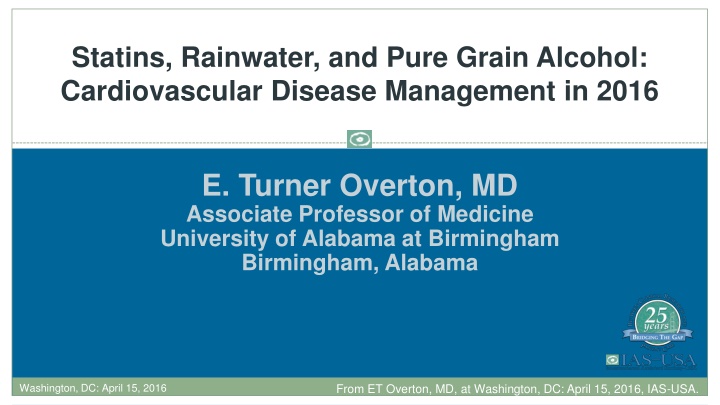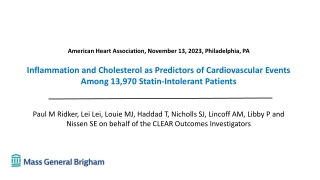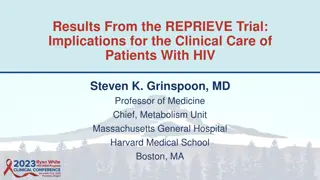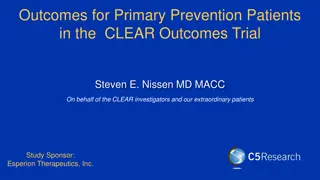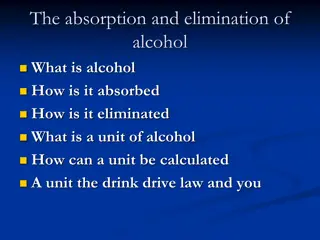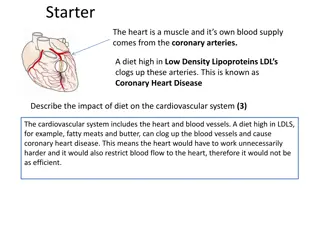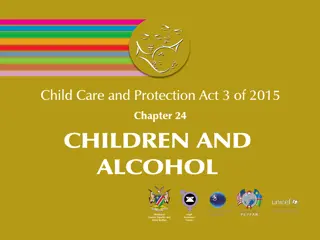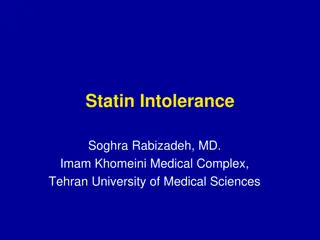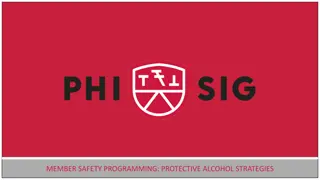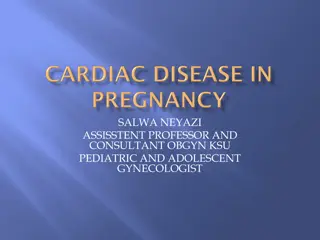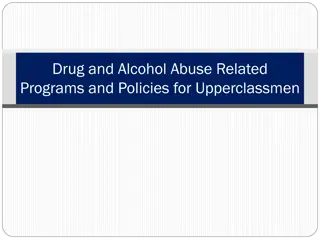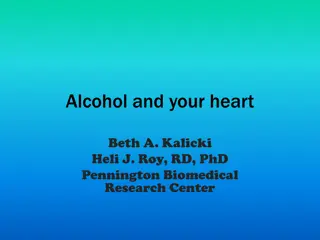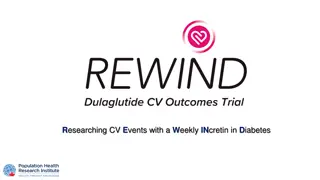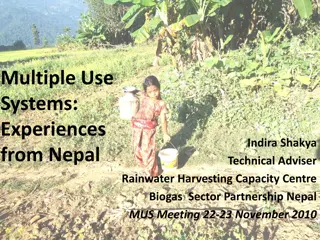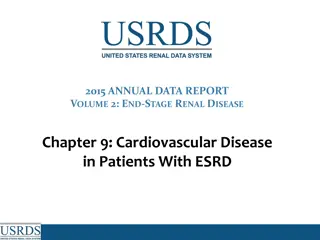Statins, Rainwater, and Pure Grain Alcohol: Cardiovascular Disease Management
Turner Overton, MD, discusses cardiovascular disease management in 2016, focusing on the role of statins, rainwater, and pure grain alcohol. The talk took place in Washington, DC, on April 15, 2016.
Download Presentation

Please find below an Image/Link to download the presentation.
The content on the website is provided AS IS for your information and personal use only. It may not be sold, licensed, or shared on other websites without obtaining consent from the author.If you encounter any issues during the download, it is possible that the publisher has removed the file from their server.
You are allowed to download the files provided on this website for personal or commercial use, subject to the condition that they are used lawfully. All files are the property of their respective owners.
The content on the website is provided AS IS for your information and personal use only. It may not be sold, licensed, or shared on other websites without obtaining consent from the author.
E N D
Presentation Transcript
Statins, Rainwater, and Pure Grain Alcohol: Cardiovascular Disease Management in 2016 E. Turner Overton, MD Associate Professor of Medicine University of Alabama at Birmingham Birmingham, Alabama FINAL: 04/06/16 Washington, DC: April 15, 2016 From ET Overton, MD, at Washington, DC: April 15, 2016, IAS-USA.
Learning Objectives After attending this presentation, participants will be able to: Describe HIV pathogenesis in the setting of viral suppression Demonstrate how end organ disease is unique in the setting of HIV disease. Cardiovascular Disease as an example. Recognize the potential for statins to prevent non-AIDS events and the need for additional data. From ET Overton, MD, at Washington, DC: April 15, 2016, IAS-USA. Slide 2 of 13
Atherosclerosis: An Inflammatory Process An atherosclerotic lesion develops as focal thickening of the inner layers of the artery Vascular endothelial cells Smooth muscle cells Immune cells T lymphocytes, macrophages, & neutrophils Plaque formation is triggered by Arterial wall injury Lipoprotein deposition Endothelial activation Pro-inflammatory molecules Early Atherogenesis Advancing Atheroma Recruitment of inflammatory monocytes Macrophage replication Foam cell formation Libby et al JACC; 2016, 9: 1091-1103 From ET Overton, MD, at Washington, DC: April 15, 2016, IAS-USA. Slide 3 of 13
CVD Mortality Higher in HIV-positive, even with Suppressed HIV Virus. 145,009 HIV+ subjects reported 2001-2012 71% male, median age 49 yrs CVD mortality 54% increase (7 13%) Decreasing in gen population aHR 1.54 (95% CI: 1.47-1.62) Adjusted for age, sex, race/ethnicity, location, and year Impact of HIV on risk comparable to traditional risk factors including HTN, DM and hyperlipidemia. Rate if VL > 400cp/mL: Rate if VL suppressed: General population: 7.7/1000pt yr 3.9/1000pt yr 3.2/1000pt yr Hanna et al. CROI 2015. February 23-26, 2015. Seattle, Washington. Abstract 729. Freiberg et al. JAMA Intern Med. 2013 Apr 22;173(8):614-22. From ET Overton, MD, at Washington, DC: April 15, 2016, IAS-USA. Slide 4 of 13
The Inflammation Hypothesis Many pathogenic stimuli induce a similar inflammatory response. Interleukins Tumor Necrosis Factor TGF-beta With removal of the stimulus, healing ensues. Inflammation decreases Healing occurs When the stimulus persists Pathogenic responses occur Fibrosis Tissue destruction Altered function Progressive Disease Forrester and Libby. American Journal of Cardiology; 2007, 5: 732 738 Persistent HIV Infection END ORGAN DISEASE From ET Overton, MD, at Washington, DC: April 15, 2016, IAS-USA. Slide 5 of 13
Proportions of monocyte subsets are altered in HIV-1 -Monocyte populations are altered with HIV infection -Decreased classic monocytes (CD14++CD16-) -Increased CD16+ monocytes (elevated inflammation) -While HAART and virologic control shift monocyte populations towards normal, they remain altered compared with healthy non-HIV infected individuals. Funderburg N T et al. Blood 2012;120:4599-4608 From ET Overton, MD, at Washington, DC: April 15, 2016, IAS-USA. Slide 6 of 13
HIV, Oxidized LDL and Monocytes Oxidized LDL is elevated in HIV infection OxLDL correlates with sCD14 Inflammatory monocytes From ET Overton, MD, at Washington, DC: April 15, 2016, IAS-USA. Zidar et al. JAIDS 2015. Slide 7 of 13
How is HIV Unique? Unique Features of HIV: Depletion of key regulatory T cell populations Changes in gut mucosal integrity Excess bacterial translocation Promotion of systemic inflammation Lymphocyte activation Monocyte activation Elevated circulating inflammatory biomarkers Neutrophil activation Hypercoagulable state Pro-atherogenic lipid profile From ET Overton, MD, at Washington, DC: April 15, 2016, IAS-USA. Boccara F, et al. J Am Coll Cardiol. 2013;61:511-523 Slide 8 of 13
How to Beat Inflammation Treat early! Continue ART. Maintain undetectable viremia Stop smoking Maintain normal weight If overweight, lose at least 5-10% of body weight Exercise Have a healthy diet Cut down on alcohol, avoid drugs From ET Overton, MD, at Washington, DC: April 15, 2016, IAS-USA. Slide 9 of 13
High risk condition and residual risk: HIV-infected persons KEY RECOMMENDATIONS Clinicians should be aware that HIV-infected patients are at increased risk for ASCVD. Risk is independent of major established risk factors. A fasting lipid panel should be obtained in all newly identified HIV-infected patients. For primary prevention, HIV infection may be counted as an additional risk factor for risk stratification. Statin therapy is first-line therapy for elevated LDL-C and non-HDL-C. Drug-drug interactions must be considered. Atorvastatin, rosuvastatin, and pitavastatin are preferred agents. From ET Overton, MD, at Washington, DC: April 15, 2016, IAS-USA. Slide 10 of 13
Suggested Statins in the Setting of ART Ritonavir or Cobicistat Containing Regimens High Intensity Statin Moderate Intensity Statin Low Intensity Statin Atorvastatin 20mg Atorvastatin 10mg Pravastatin 10-20mg Rosuvastatin 10-20mg Rosuvastatin 5mg Fluvastatin 10-20mg Pravastatin 40-80mg* Pitavastatin 1mg Pitavastatin 1mg Simvastatin and lovastatin are contraindicated for patients receiving a PI or cobicistat. *With darunavir, reduce pravastatin to 20-40mg. NNRTI, Raltegravir, or Dolutegravir Containing Regimens High Intensity Statin Moderate Intensity Statin Low Intensity Statin Atorvastatin 40-80mg Atorvastatin 10-20mg Pravastatin 10-20mg Rosuvastatin 20mg Rosuvastatin 10mg Fluvastatin 20-40mg Pravastatin 40-80mg Pitavastatin 1mg Pitavastatin 2-4mg Lovastatin 20mg Lovastatin 40mg Simvastatin 10mg Simvastatin 20-40mg From ET Overton, MD, at Washington, DC: April 15, 2016, IAS-USA. Adapted from Dub MP. Lipid Management, DOI 10.1007/978-3-319-11161-2_14 Slide 11 of 13
Statins: Ideal Strategy to Reduce Non-AIDS and Vascular Events in HIV Traditional effects to lower LDL, effective to lower LDL (-26%), with few AEs (myositis 1.9%) in HIV Silverberg Annals 2009 Pleiotropic effects to reduce monocyte activation, chemo-attraction and vascular inflammation Funderburg CID 2013, Eckard JID 2014 Reduce events even among nonHIV patients with low LDL but increased inflammationJupiter NEJM 2008 Use is low among HIV patients (19.6% in ACTG), clinicians awaiting results from RCTs ACTG survey From ET Overton, MD, at Washington, DC: April 15, 2016, IAS-USA. Slide 12 of 13
Conclusions HIV and its therapy contribute to cardiac risk along with the traditional host factors Controlling viral replication partially reduces CVD risk. Early ART may significantly mitigate HIV-associated CVD risk. No reliable inflammatory markers to predict risk. Currently available risk scores fail to accurately estimate CVD risk in the setting of HIV infection. Smoking cessation, dietary and exercise interventions are effective. Statins may be of benefit in addition to lipid lowering effects. HOWEVER, more data are needed to inform use in traditional low risk populations. From ET Overton, MD, at Washington, DC: April 15, 2016, IAS-USA. Slide 13 of 13
